
University of Nebraska - Lincoln University of Nebraska - Lincoln
DigitalCommons@University of Nebraska - Lincoln DigitalCommons@University of Nebraska - Lincoln
Library Philosophy and Practice (e-journal) Libraries at University of Nebraska-Lincoln
Fall 9-9-2022
Assessing the e5cacy of electronic document management Assessing the e5cacy of electronic document management
system in records management at Sokoine University of system in records management at Sokoine University of
Agriculture Agriculture
Andrew Malekani
Alex Bahame Alphonce ABA
Sokoine University of Agriculture
Follow this and additional works at: https://digitalcommons.unl.edu/libphilprac
Malekani, Andrew and Alphonce, Alex Bahame ABA, "Assessing the e5cacy of electronic document
management system in records management at Sokoine University of Agriculture" (2022).
Library
Philosophy and Practice (e-journal)
. 7417.
https://digitalcommons.unl.edu/libphilprac/7417

1
Assessing the efficacy of electronic document management system in records
management at Sokoine University of Agriculture
By
Malekani, A.W and Alphonce, A. B
Sokoine University of Agriculture (SUA)
Corresponding Author: Malekani, A.W (PhD)
E-mail: [email protected]
Abstract
This study was conducted at Sokoine University of Agriculture (SUA) in the year 2022. The
objective of this study was to assess the efficacy of EDMS in accessibility and use of records
at Sokoine University of Agriculture. Specifically, the study was geared to find out the way
EDMS is used in accessing and using documents at Sokoine University of Agriculture. The
study used a cross section research design where by the data were collected at one time based
on two approaches which are qualitative and quantitative. The study used a sample size of 100
respondents who were all SUA staff. 100 respondents were selected by using purposive
sampling techniques, simple random and systematic random sampling from a population of
1300 SUA staff who. Results indicate that the use of SUA – EDMS is not difficult because
majority of them (100%) reported that they are using EDMS. The study revealed that only
leave of absence was a major document accessed using EDMS followed by annual leave and
maternity leave. It was therefore concluded that the adoption of EDMS has to some extent
reduced paper work in managing records at SUA. However, respondents were of the opinion
that EDMS should improve on accessing other documents in the system like paternity leave,
study leave and imprest forms. Moreover, EDMS should be improved to ensure EDMS is
stable and available all the time, improving internet bandwidth speed, stability of power
supply as well as find other alternatives for power supply. The EDMS should allow users to
recover their own passwords instead of depending on system administrator to assign
passwords all the time. But also regular training should be provided on how to use EDMS and
change management.
Keywords: Electronic document management system, document management, electronic
records management, records management, SUA.
Background of the study.
Developments in information and communication technologies have led to the growth of
electronic document management systems (EDMS), which have therefore resulted into
2
most public and private sector or organizations around the world to adopt in a plan to
improve the management of electronic records (Abdulkadhim, et al., 2015). The ease with
which electronic information is created, received, changed and transmitted has led to the
devolution of records management responsibilities to employees who may not be trained
in, or wish to perform, this role (Joseph, 2010). Records managers today come upon a
much wider range of records, paper-based and electronic, than they dealt with even ten
years ago. Even the strategies adopted for integrating and managing paper and electronic
records will be subject to change over time (Pauline, 2008).
An electronic document management system (EDMS) is defined as an automated,
electronic document and records management system that enables organizations to
manage unstructured information captured in paper and electronic formats, such as emails,
word processed and spreadsheet contents (Pauline, 2008). EDMS supports many
governments organizations to improve work process and forms publication, easier search
of governmental or organizational records, cost saving from low use of materials.
Furthermore, EDMS increases efficiency as well as effectiveness of services in the
government organization, increases transparency and accountability in making informed
decisions and enhances efficient and cost effective services to the public (Johnston and
Bowen, 2005: Abdulkadhim et al., 2015).
However, despite the remarkable benefits offered by EDMS and also attention shown by
many governments to implement EDMS, many initiatives have failed to implement
EDMS, particularly in developing countries (Abdulkadhim et al., 2015). SUA as a part
of public organization in Tanzania is estimated to have more than one thousand and three
hundred (1300) employees. Therefore, due to the large number of employees with more
than one campus which is scattered, to handle their records or documents using manual
system or paper based system is very difficult. Therefore, in 2019 SUA officially decided
to establish EDMS. This study focuses on the efficacy of EDMS from three perspectives;
firstly, it will efficacy of EDMS in using and accessing of documents at SUA; secondly,
it will evaluate the challenges facing employees in using and accessing EDMS and thirdly,
3
it will assess employee’s perceptions on the use of EDMS in Sokoine University of
Agriculture.
Statement of the problem
Adaptation of EDMS in organizations aims to enhance accelerating work processes,
delivering services to employees, increasing transparency and accountability as well as
fast track decision making, while also lowering costs of operation (Bowen and Johnston
2005), (Luisa, Di Biagio and Ibiricu, 2008). Despite the fact that organizations have
adopted EDMS but they have failed to perform as expected. However, as shown by
Abdulkadhim, Bahari, Bakri and Ismail (2015), many initiatives to implement EDMS
especially in developing countries have failed. Some factors that have been cited as major
interruptions are observed to be strategic, social and technical in nature. (Kwatsha, 2010).
Sæbø, (2012) add that the main challenges of implementing E-government in Tanzania
were lack of IT-skilled staff, lack of influence on how to prioritize, lack of funding and
lack of awareness of the opportunities and potential of E-government.
Various studies have shown that implementation of new system is difficult due to the
difference factors such as environment, availability of resources and willingness of top
management. Thus, each country or organization has its own ways of implementing new
systems as well as challenges vary from one country or organization to another. For
instance, majority of the studies reviewed, such as Abdulkadhim et al., (2015), Kwatsha,
(2012), Joseph, (2009), Pauline (2008), Bowen and Johnston (2005), Sæbø, (2012)
focused on the implementation, benefits, challenges on use of EDMS as well as
perceptions towards EDMS.
Statistics shows that SUA have 1308 (one thousand three hundred and eight) employees.
(SUA workers’ council report December, 2021) Therefore, due to the large number of
employees with more than one campus which are scattered, to handle their documents
using manual system or paper based system is very difficult. So, the implementation of
4
EDMS is inevitable. But the efficacy of the system in terms of usage, accessibility and
employee’s perception is questionable which forms the gap that this study sought to
address. Therefore, this study intended to assess the efficacy of EDMS in public
organization on use and access of documents in SUA as a tool for improving the workflow,
flow of communication as well as work efficiency. Specifically, the study sought find out
the accessibility of EDMS at SUA and the way it is used by staff in their daily activities.
Justification of the study
The study to this end was meant to clarify effectiveness of the EDMS to SUA top
management, policy makers, researchers and all stakeholders in the public organization.
From the perspective of policy makers, it was thought to enrich their sense of focus as to
how best they can formulate, implement and amend EDMS policies. Top management
will know the positive impacts of EDMS. From the perspective of researchers, it was
thought to stimulate up interest in studying related topics in other researches. The findings
of the study were also meant to assist in providing data, information and knowledge for
proper planning, reduce the challenges facing the system as well as decision at the national
and public institution level. Researchers would apply the recommendations of this study
in adding new knowledge in area of the study.
LITERATATURE REVIEW
Introduction
This chapter reports the literature review. It is the review of earlier studies associated to
the research topic. Issues discussed in this chapter include, efficacy of EDMS in using and
accessing of documents at SUA in terms of its accessibility, effectiveness to achieve
intended results and the way it is used by staff.
Efficacy of EDMS in using and accessing of documents
In a study done Friedman and Hagood (2002), it was indicated that to evaluate system
effectiveness it is imperative to develop a balanced scorecard based on objective measures
in the aspects of user satisfaction, internal process efficiency, resources use, and individual
5
impact as well as the frequency of used. Cho, (2007) added that success level of
information System effectiveness depends on the quality of the system itself, its output
information, its use level, whether users are satisfied with it, and its impact on individual
and the organization.
Coombs et al., (1999) have proved that there is a relationship between organizational
characteristics and system success. The study indicated that there are six groups of factors
crucial for EDMS successes. These include technological readiness, top management
support, training and involvement, resource availability, system-related factors, as well as
work environment and culture (Jones, 2012, Nguyen, 2011 and Hjelt, 2006). Moreover,
the study has also determined the ranking of these factors in relations to their importance.
The factor group “system-related factors” is thought the most important of all for
successful EDMS implementation, followed by “top management support,” “resource
availability,” “training and involvement,” “technological readiness,” and “work
environment and culture.” Therefore, there is a relationship between organizational
characteristics and efficacy of EDMS. There is therefore scant information the efficacy of
electronic document management system (EDMS) in public organization on access and
use of records, particularly at Sokoine University of Agriculture in Tanzania. This calls
for a study of this kind.
RESEARCH METHODOLOGY
Introduction
This section discusses the research methodology which was applied during the study
including description of the study area, research design, study population, sampling
techniques and size, data collection methods and instruments, data collection procedures
and data analysis.
6
Description of the Study Area
This study was conducted at Sokoine university of Agriculture which is located in
Morogoro region in Tanzania about 200 km west of Dar es Salaam.
Research design
Research design is purposely meant to ensure that the study is relevant to the problem and
economical based on two approaches which are qualitative and quantitative. Therefore,
the study employed quantitative and qualitative research design.
Study population
The targeted population included 1300 employees from SUA which are categorized into
three groups which are; academic staffs, administrative staff and technical staffs.
Sample size
In this study a number of respondents were selected by using purposive sampling
techniques, simple randomly and convenience sampling to select 100 respondents from
1300 SUA staff who are Administrative staff, Academic staffs, and IT staff.
Sampling Techniques
The researcher adopted probability and non-probability sampling whereby purposive
sampling was used to select IT staff as key informants and convenience sampling was
used to get academic staffs and simple random sampling was used to get administrative
staffs.
Data collection methods and instruments
The researcher used questionnaires and interviews guides to collect primary and
secondary data. The questionnaire contained both closed and open ended questions.
Secondary data was obtained from both published and unpublished documents and
working records which are available at SUA.
7
Data Analysis
In this study the researcher used Statistical Package for Social Sciences (SPSS) V16 to
analyze quantitative data. Output was presented in form of tables, graphs, charts and
figures. Qualitative data from interviews with key informants and open ended questions
were analyzed through content analysis. Here non-statistical feedback and opinions
rooted in people’s feelings, attitudes, behavior were collected and organized in themes for
interpretation (Jacob and Razarich, 2002).
PRESENTATION AND DISCUSSION OF RESEARCH FINDINGS
Introduction
This section deals with presentation and discussion of the findings. The discussion is
based on objectives of the study which were to find out the accessibility of EDMS at SUA
and the use pattern by staff in their daily activities. The section also discusses the social
demographic characteristics of respondents to ascertain their suitability for eliciting
relevant data for the study.
Social demographic characteristics of respondents
This part presents findings on characteristics of respondents. The study involved SUA
staff grouped into three categories of academicians, technicians and administrative staff.
Total number of respondents participated in the study were 100, all are SUA staff. Social
demographic characteristics are very important in the study to show the suitability of the
respondents for eliciting suitable data, and literature in different parts of the world shows
that various socio-demographic factors influence the use or acceptance of technology.
Gender distribution of the respondents
The demographic composition of the respondents revealed that 61(61.0%) of respondents
were male SUA staff while 39 (39.0%) of respondents were female SUA staff (Figure 1).
These findings suggest that even if men slightly exceeded the number of women, but both
sexes were represented in the study. This slight variation in terms of gender composition
may be due to historical and cultural background that promotes more male participation
in education than females. According to Aina (2004), in developing countries like
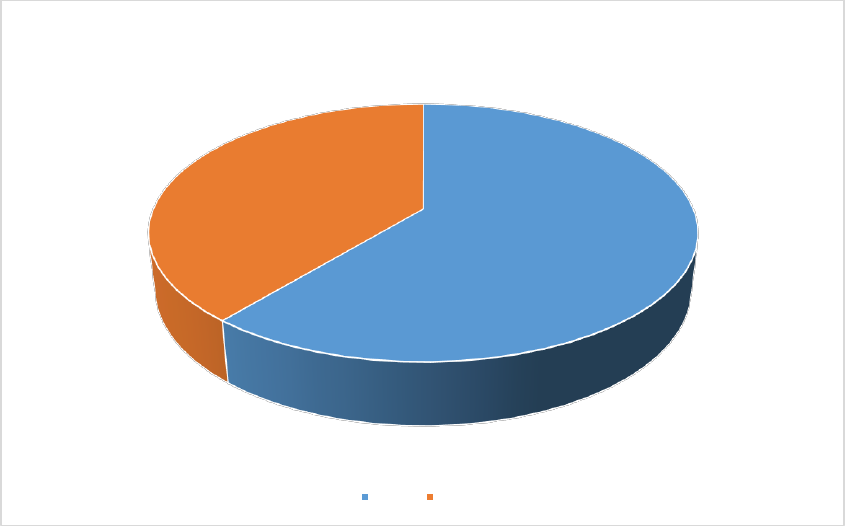
8
Tanzania, extending access to education and training is often difficult because of bad
cultural practices and high educational cost. One of the cultural malpractices in the
Tanzanian society is giving boys first priority to any available education opportunity
rather than the girls. This is similar with Mutimba, (2014), who in the study aimed to
investigate the success of the implementation of electronic document and records
management system in the Ministry of Higher Education Science and Technology found
that more than half of the majority of the respondents who participated in the study and
were users of the technology were male.
Figure 1 Gender of respondent
Age distribution of the respondents
Age of respondents shows that majority of the respondents 44% had age range between
41 – 50 years followed by 28% with age range between 31 - 40 years. Again the results
61, 61%
39, 39%
Gender of respondent
Male Female
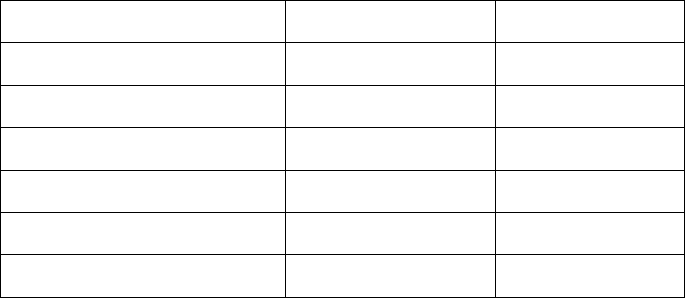
9
show that 13% had age range between 51 – 60 years and 12% had age range between 18-
30 years. Only 3% had age range above 60 years (Table 1).
Age is another characteristic or variable which determines the use of new system. Young
participants are keen to get information than older participants. Older ones are more risk
averse and less likely to be flexible than younger ones and thus have a lesser possibility
of system utilization and the adoption of new technologies (Alam et al., 2018; Tata and
Mcnamara, 2018).
Table 1: Age distribution of the respondents
Age range (years)
Frequency
Percent
41-50
44
44
31-40
28
28
51-60
13
13
18-30
12
12
Above 60
3
3
Total
100
100
Education level of the respondents
In regard with education level, data in Figure 2 shows that nearly a half of the respondents
that participated in the study had Master’s level of education as reported by 39% of the
respondents followed by 23% who had Doctorate level of education. 21% had
Diploma/certificate level of education, and 17% of the respondents had Bachelor level of
education (Figure 2).
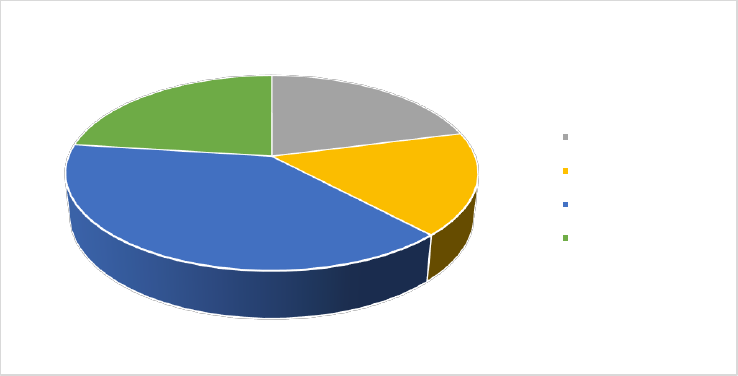
10
Education has been valued as a means for increasing knowledge about invention. An
individual with education becomes critically aware of the need and scope for social
change. Education is associated with a high level of intellectual capacity of new skills and
expands knowledge (Mwalukasa, 2020). Education enables the individual users to know
how to seek information on improved EDMS practices. This is because, as individuals get
knowledge, they want to extend the scope of their experience through the modern sources
of information. This means, education level is the factor that drives individuals to choose
or accept a certain technology.
Figure 2 Education level of respondents
Ways in which EDMS skills were acquired
The question was asked to the SUA staff with aim of knowing how they learned to use
SUA EDMS. Data in Table 2 shows that 46.8% of respondents who participated in the
study learned to use SUA EDMS through colleagues, followed by 21.8% of respondents
who said that they learned to use SUA EDMS experience. Those who learned it through
short course conducted from ICT experts were 14.5%. 16.9% reported that they learned
0, 0%
21, 21%
17, 17%
39, 39%
23, 23%
Diploma/certificate
Bachelor
Masters
Doctorate

11
to use SUA EDMS through self-learning, and 18(18%) reported that they learned to use
SUA EDMS through short courses conducted by ICT experts. These results concur with
research carried out by Kaaki (2013) which found that more than half of respondents
learned to use EDMS from colleagues. This implies that individual efforts in learning a
new technology is higher than skills acquisitions from ICT experts contrary to what would
have been done by the organization to conduct formal training sessions for staff to equip
them with more skills on use of EDMS effectively.
Table 2: Ways used to get knowledge and skills on use of EDMS at SUA
Variable
Frequency
Percentage
Short course from ICT expert
18
14.5
Through experience
27
21.8
Self learning
21
16.9
Leaen from others
58
46.8
Note: This was multiple response question, meaning that respondents were required to
answer all the responses applicable.
Respondents were asked to indicate what kind of document do they access from SUA
EDMS. All respondents (100%) reported that they access only leave of absence as a
document. 9% of respondents reported that they access leave of absence and annual leave
as a document through EDMS, while 3% respondents reported that they access study leave
as a document through EDMS. Moreover, 2% of respondent apart from accessing leave
of absence they access also Maternity leave as a document through SUA-EDMS (Table
3). From these results, it can be said that the EDMS at SUA has limited features or
functionalities in managing documents/records. These might be due to fear of exposing
multiple documents to staff which may compromise issues of copyright, privacy and
similar matters.

12
Similar studies have been conducted in Southern, Eastern, Central and Sub-Saharan
African countries. In southern Africa scholars such as Mosweu et al., (2014) and Shonhe
et al., (2019) have revealed that, change management, privacy and security are among the
challenges facing ERMS. In Malawi, scholars like Msiska et al., (2017) and Chawani
(2014) state that, lack of expert, lack of knowledge and ICT facilities has been observed
to exacerbate challenges related to accessing and tracing records stored.
“In support to these findings, the interview done from the EDMS administrator said that
shortage of funds is the main reason for users to access only leave of absence. He
mentioned other reasons like poor support from top management as well as poor ICTs
infrastructure”.
Table 3: Kind of documents accessed from EDMS at SUA
Variable
Frequency
Percentage
Absence leave
100
100
Maternity leave
2
2
Paternity leave
0
0
Study leave
3
3
Annual leave
9
9
Speed of SUA EDMS during document processing
In respect with speed of SUA EDMS during document processing, the finding shows that
43% respondents who participated in the study reported that the speed of EDMS during
document processing was slow, followed by 35% who reported that it was faster, 15%
reported it to be very fast and 7% of the respondents reported that it was very slow (Figure
3). This can be due to the poor ICTs infrastructures such as poor network bandwidth,
fluctuation or unstable power supply, kind of electronic devices used by user of SUA-
EDMS as well as low server capacity.
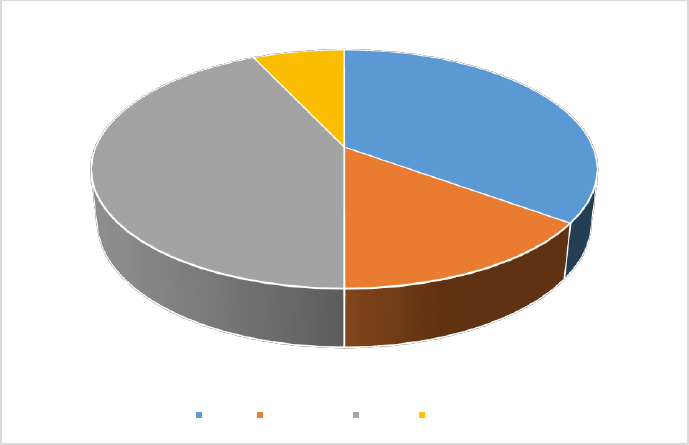
13
Figure 3 Speed of SUA EDMS during document processing
Rating on effectiveness of SUA EDMS in retrieving documents
The respondents were asked to rate the effectiveness of SUA EDMS in retrieving
documents. A majority of the respondents (more than half) 61 (61%) rated it to be good.
Followed 34 (34%) who rated fairy good and 5 (5%) who rated very good (Figure 4).
Thus, in terms of accomplishing output the system was good as most leave of absence
were retrieved back by the administrator and feedback was given to responsible permit
requesters. This finding implies that EDMS users perceived that the use of the system
enabled them to overcome limitations of paper-based system and improved services
delivery. These findings are significant in the fact that EDMS contributed to the success
of individuals. Thus, all these factors have a significant impact on modern technology
adoptions and strong predictor of technology acceptance.
35, 35%
15, 15%
43, 43%
7, 7%
Fast Very fast Slow Very slow

14
Figure 4 Rating on effectiveness of SUA EDMS in retrieving document
Overall rating on usefulness of EDMS in managing records at SUA
The study results in Figure 5 show the respondents overall rating on usefulness of EDMS
in managing records at SUA. The results show that, of the 100 respondents, most, (44%)
of the respondents reported that overall, EDMS at SUA was useful in managing record at
SUA, followed by 28% of the respondents who reported that the technology was
somewhat useful. Furthermore, 26% of respondents reported that the technology was very
useful, while very few, (2%) said that the technology was not useful. The rate of usage of
EDMS differ from one individual to another, one organization to another as well as from
one country to another due to the various factors; for the perspective of individual level
age, education level, work experience and nature of work are among of factors cause
difference. For the perspective of organization or/and country financial constraint,
technological obsolescence, as well as organization / country culture are among of the
factors cause difference.
34, 34%
61, 61%
5, 5%
Fairy good Good Very good
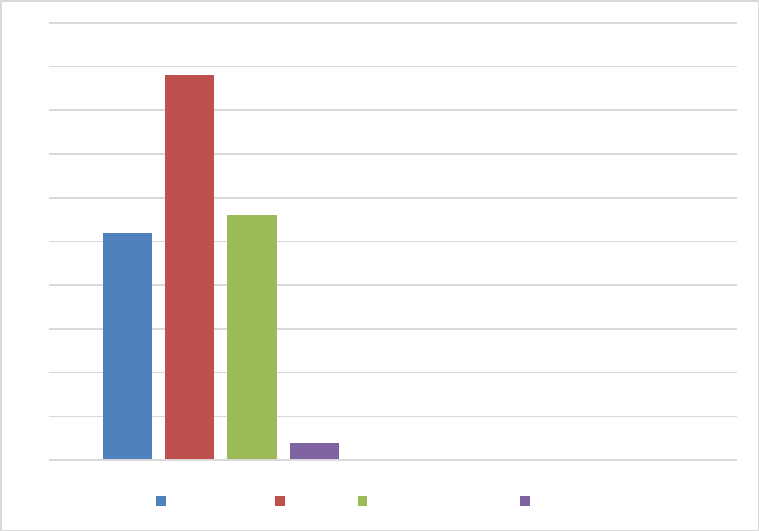
15
Figure 5 Overall rating on usefulness of EDMS in managing records at SUA.
CONCLUSION AND RECOMMENDATIONS
Conclusion
Based on the findings and discussion above, it can be concluded that SUA EDMS has
achieved some expectations for reducing paperwork in managing documents despite some
negative challenges that staff perceive they are not yet in place.
Recommendations
Taking into consideration the findings of the study, electronic records management
systems need to be improved to ensure that it’s implemented successfully to the latter.
Electronic document and records management systems need to be implemented to ensure
timely retrieval of records for speedy decision making with regards to the organization’s
mandate. The study therefore makes the following recommendations:
26
44
28
2
0
5
10
15
20
25
30
35
40
45
50
Very useful Useful Somewhat useful Not useful
16
1. Regular training by ICT technicians should be provided to other staff on how to
use EDMS and change management.
2. EDMS administrator/Technicians should add others features in the system like,
maternity leave, annual leave, paternity leave, study leave and impress form.
3. EDMS administrator/technicians and SUA management should ensure that it is
stable and available all the time by improving internet bandwidth, speed, improve
stability of power supply as well as find other alternative for power supply.
4. The EDMS administrator/technicians should allow users to recover their own
passwords once they are forgotten to expedite the use of the system all the time.

17
Bibliography
Aina, I. O. (2004). Library and information science text for Africa. Ibadan: Sam-Adex
printers.
Alam, G. M., Alam, K., Mushtaq, S., Khatun, M. N. and Mamun, M. A. K. (2018).
Influence of socio-demographic factors on mobile phone adoption in rural
Bangladesh: Policy implications. Information Development 34(5): 211–221.
Ho, K. F., Ho, C. H., and Chung, M. H. (2019). Theoretical integration of user satisfaction
and technology acceptance of the nursing process information system. PLoS
ONE, 14(6), 1–14. https://doi.org/10.1371/journal.pone.0217622
Issa, M., and Wamukoya, J. (2018). The Role of Electronic Records Management in
Promoting the Delivery of Justice in Tanzania: Perspectives from Dar es Salaam.
Information and Knowledge Management, 8(2), 30–35.
Kamatula, G. (2018). A framework for e-records in support of e-government
implementation in the Tanzania public service. (October), 121.
Kaaki, F, Rayner, C and Alshamrani, M, (2013). Female Users’ Acceptance of the
Electronic Document Management System (EDMS). IEEE DOI
29910.1109/EMS.2013.54: 320 pp.
Lwoga, T. (2020). Predictors of electronic health management information system for
improving the quality of care for women and people with disabilities. Jdr, (2001),
3–29.
Mutimba, C. J. (2014). Implementation of electronic document and records
management system in the public sector: a case study of the ministry of higher
education science and technology. Naironi: University of Nairobi
Ojo, A. I. (2017). Validation of the delone and mclean information systems success
model. Healthcare Informatics Research, 23(1), 60–66.
https://doi.org/10.4258/hir.2017.23.1.60
Tata, J. S. and McNamara, P. E. (2018). Impact of ICT on agricultural extension services
delivery: evidence from the Catholic Relief Services SMART skills and farm
book project in Kenya. The Journal of Agricultural Education and Extension
24(1): 89-110.
